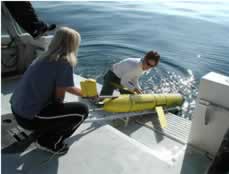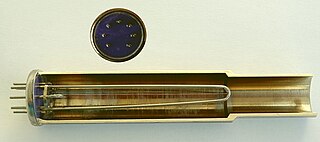Capability
SPURV II had variable speed, and could run for about 6 hours to depths of 1500 meters. It carried instruments to measure temperature and velocity with taken at 1 kHz, temperature and conductivity taken at 100 Hz, and temperature conductivity, pressure, and dye concentration at 10 Hz.
SPURV II was quite a bit different in its 1975 operational state than its final 1979 state. The instrumentation and the internal recording system capacity were significantly increased, and all of the sensors—temperature and velocity at 1 kHz, temperature, conductivity and velocity at 100 Hz, and (more precisely) temperature, conductivity, dye concentration, and pressure (depth) at 10 Hz—could be recorded for up to 6 hours.

Sonar is a technique that uses sound propagation to navigate, communicate with or detect objects on or under the surface of the water, such as other vessels. Two types of technology share the name "sonar": passive sonar is essentially listening for the sound made by vessels; active sonar is emitting pulses of sounds and listening for echoes. Sonar may be used as a means of acoustic location and of measurement of the echo characteristics of "targets" in the water. Acoustic location in air was used before the introduction of radar. Sonar may also be used in air for robot navigation, and SODAR is used for atmospheric investigations. The term sonar is also used for the equipment used to generate and receive the sound. The acoustic frequencies used in sonar systems vary from very low (infrasonic) to extremely high (ultrasonic). The study of underwater sound is known as underwater acoustics or hydroacoustics.
Atmospheric pressure, sometimes also called barometric pressure, is the pressure within the atmosphere of Earth. The standard atmosphere is a unit of pressure defined as 1013.25 mbar (101.325 kPa), equivalent to 760 mmHg (torr), 29.9212 inches Hg, or 14.696 psi. The atm unit is roughly equivalent to the mean sea-level atmospheric pressure on Earth, that is, the Earth's atmospheric pressure at sea level is approximately 1 atm.
Flow measurement is the quantification of bulk fluid movement. Flow can be measured in a variety of ways. The common types of flowmeters that find industrial application can be listed as below:
a) Obstruction type(differential pressure or variable area)
b) Inferential(turbine type)
c)electromagnetic
d)Positive-displacement flow meters accumulate a fixed volume of fluid and then count the number of times the volume is filled to measure flow.
e)fluid dynamic(vortex shedding)
f)Anemometer
g)Ultrasonic
H)Mass flowmeter(Coriolis).
An oxygen sensor (or lambda sensor, where lambda refers to air–fuel equivalence ratio, usually denoted by λ) is an electronic device that measures the proportion of oxygen (O2) in the gas or liquid being analysed.

An autonomous underwater vehicle (AUV) is a robot that travels underwater without requiring input from an operator. AUVs constitute part of a larger group of undersea systems known as unmanned underwater vehicles, a classification that includes non-autonomous remotely operated underwater vehicles (ROVs) – controlled and powered from the surface by an operator/pilot via an umbilical or using remote control. In military applications an AUV is more often referred to as an unmanned undersea vehicle (UUV). Underwater gliders are a subclass of AUVs.
The manifold absolute pressure sensor is one of the sensors used in an internal combustion engine's electronic control system.

An underwater glider is a type of autonomous underwater vehicle (AUV) that uses small changes in its buoyancy in order to move up and down in the ocean like a profiling float. Unlike a float, a glider uses wings to convert that vertical motion to horizontal, propelling itself forward with very low power consumption. While not as fast as conventional AUVs, gliders using buoyancy-based propulsion represent a significant increase in range and duration compared to vehicles propelled by electric motor-driven propellers, extending ocean sampling missions from hours to weeks or months, and to thousands of kilometers of range. Gliders follow an up-and-down, sawtooth-like profile through the water, providing data on temporal and spatial scales unavailable to previous AUVs, and much more costly to sample using traditional shipboard techniques. A wide variety of glider designs are in use by navies and ocean research organizations and typically cost US$100,000.

A mass (air) flow sensor (MAF) is a sensor used to determine the mass flow rate of air entering a fuel-injected internal combustion engine.
An acoustic Doppler current profiler (ADCP) is a hydroacoustic current meter similar to a sonar, used to measure water current velocities over a depth range using the Doppler effect of sound waves scattered back from particles within the water column. The term ADCP is a generic term for all acoustic current profilers, although the abbreviation originates from an instrument series introduced by RD Instruments in the 1980s. The working frequencies range of ADCPs range from 38 kHz to several Megahertz. The device used in the air for wind speed profiling using sound is known as SODAR and works with the same underlying principles.

Underwater acoustics is the study of the propagation of sound in water and the interaction of the mechanical waves that constitute sound with the water, its contents and its boundaries. The water may be in the ocean, a lake, a river or a tank. Typical frequencies associated with underwater acoustics are between 10 Hz and 1 MHz. The propagation of sound in the ocean at frequencies lower than 10 Hz is usually not possible without penetrating deep into the seabed, whereas frequencies above 1 MHz are rarely used because they are absorbed very quickly. Underwater acoustics is sometimes known as hydroacoustics.

An electrical conductivity meter measures the electrical conductivity in a solution. It has multiple applications in research and engineering, with common usage in hydroponics, aquaculture, aquaponics, and freshwater systems to monitor the amount of nutrients, salts or impurities in the water.

The Pirani gauge is a robust thermal conductivity gauge used for the measurement of the pressures in vacuum systems. It was invented in 1906 by Marcello Pirani.
SPURV, or Self-Propelled Underwater Research Vehicle, was an Autonomous Underwater Vehicle built in 1957 at the University of Washington's Applied Physics Laboratory. The research and development of this vehicle was funded by the United States Office of Naval Research (ONR), and it became the US Navy’s first autonomous underwater vehicle (AUV). The navy used a total of 7 SPURV vehicles until 1979.

A measuring instrument is a device for measuring a physical quantity. In the physical sciences, quality assurance, and engineering, measurement is the activity of obtaining and comparing physical quantities of real-world objects and events. Established standard objects and events are used as units, and the process of measurement gives a number relating the item under study and the referenced unit of measurement. Measuring instruments, and formal test methods which define the instrument's use, are the means by which these relations of numbers are obtained. All measuring instruments are subject to varying degrees of instrument error and measurement uncertainty.

A CTD or Sonde is an oceanography instrument used to measure the conductivity, temperature, and pressure of seawater. The reason to measure conductivity is that it can be used to determine the salinity.
The Sentry is an autonomous underwater vehicle (AUV) made by the Woods Hole Oceanographic Institution. Sentry is designed to descend to depths of 4,500 metres (14,800 ft) and to carry a range of devices for taking samples, pictures and readings from the deep sea.
The SOLO-TREC is a profiling float that uses a novel thermal recharging engine powered by the natural temperature differences found at different ocean depths to cycle up and down in the ocean. The research and prototype were developed by researchers at the Jet Propulsion Laboratory in Pasadena, CA, and the Scripps Institution of Oceanography in San Diego, CA. The project name stands for "Sounding Oceanographic Lagrangrian Observer Thermal RECharging" vehicle.

The REMUS series are autonomous underwater vehicles (AUVs) made by the Woods Hole Oceanographic Institution and designed by their Oceanographic Systems Lab (OSL). More recently REMUS vehicles have been manufactured by the spinoff company Hydroid Inc. a wholly owned subsidiary of Kongsberg Maritime. The series are designed to be low cost, they have shared control software and electronic subsystems and can be operated from a laptop computer. They are used by civilians for seafloor mapping, underwater surveying, and search and recovery as well as by several navies for mine countermeasures missions.
The Tropical Atmosphere Ocean (TAO) project is a major international effort that instrumented the entire tropical Pacific Ocean with approximately 70 deep ocean moorings. The development of the TAO array in 1985 was motivated by the 1982-1983 El Niño event and ultimately designed for the study of year-to-year climate variations related to El Niño and the Southern Oscillation (ENSO). Led by the TAO Project Office of the Pacific Marine Environmental Laboratory (PMEL), the full array of 70 moorings was completed in 1994.

The Garfield Thomas Water Tunnel is the U.S. Navy's principal experimental hydrodynamic research facility and is operated by the Penn State Applied Research Laboratory. The facility was completed and entered operation in 1949. The facility is named after Lieutenant W. Garfield Thomas, Jr., a Penn State journalism graduate who was killed in World War II. For a long time, the Garfield Thomas Water Tunnel was the largest circulating water tunnel in the world. It has been declared a historic mechanical engineering landmark by the American Society of Mechanical Engineers.












